#uralic
Text
#polls#linguistics#languages#Slavic#Afro-Asiatic#ytilaremehpe-sselhtaed#Germanic#Indo-Iranian#Baltic#Romance#Uralic#Sino-Tibetan
2K notes
·
View notes
Text
Quick etymology of Käärijä
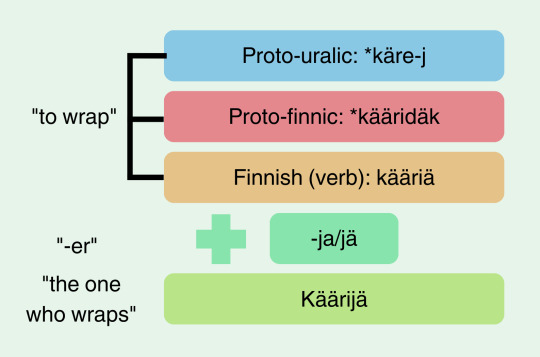
Käärijä shares the same word creation process as the following words
Juoksija - runner
Näyttelijä - actor
Aloittelija - beginner
Ajaja - driver
Esiintyjä - performer
Hakija - applicant
etc.
(Look for a longer list below!)
134 notes
·
View notes
Text




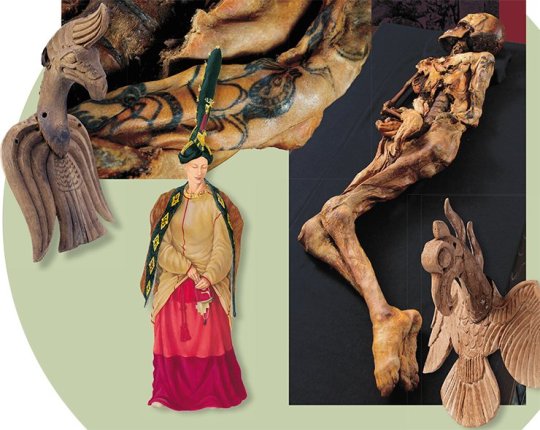
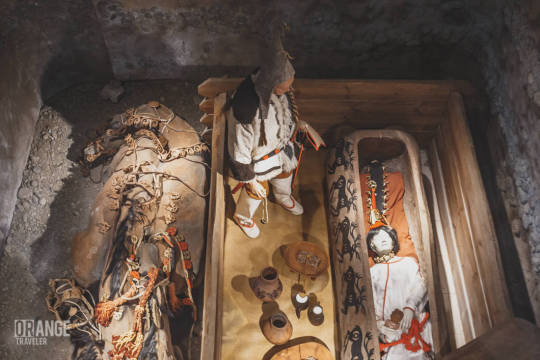
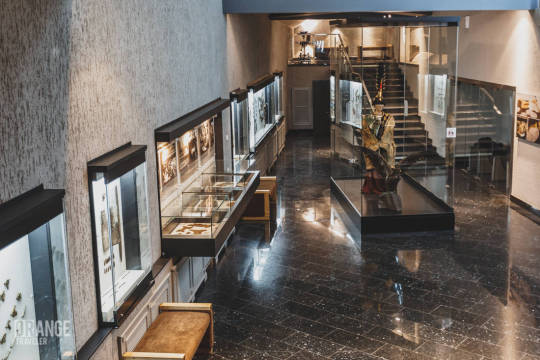








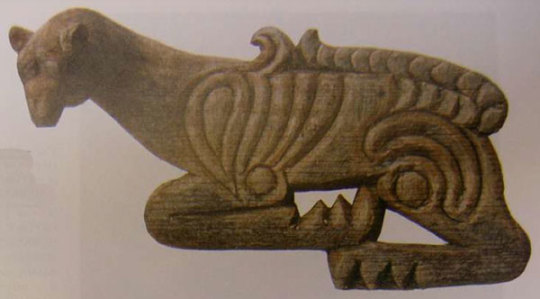




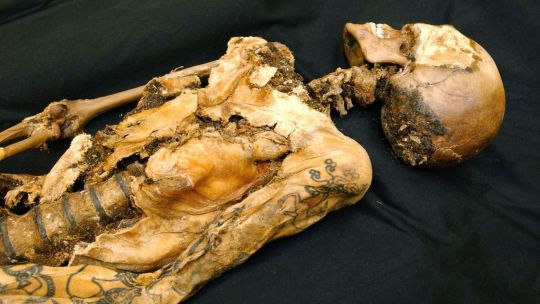
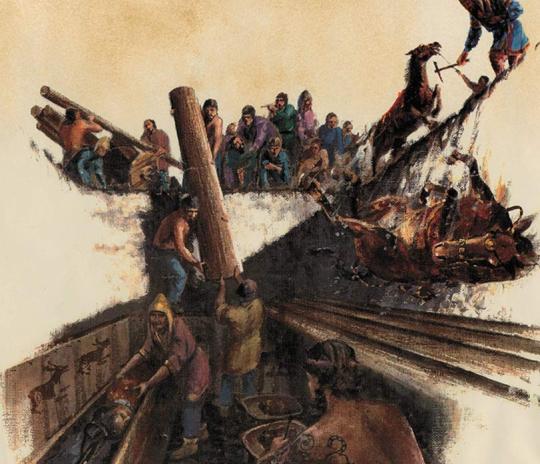
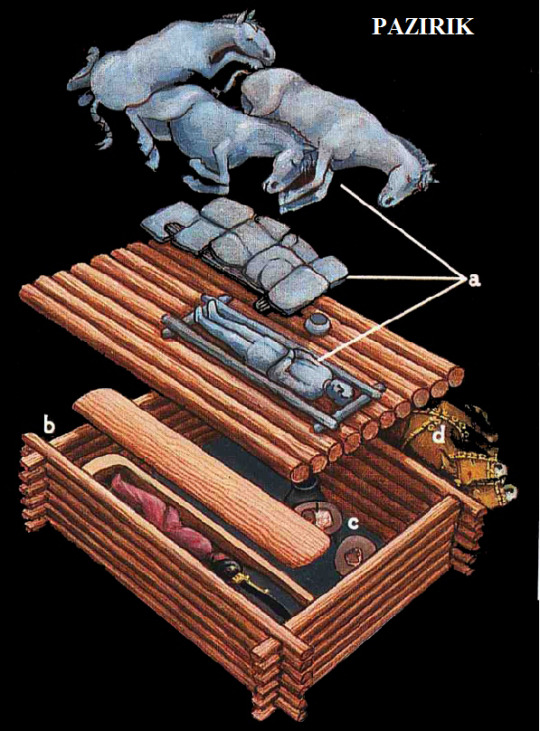
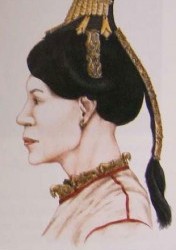




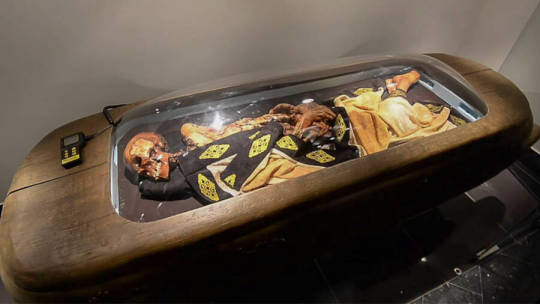

The Princess of Ukok (aka Siberian Ice Maiden & The White Lady) 500 BCE. Tumblr image limit only allows 30 photos, I will include a link to my blog, at bottom, with more photos and more organized descriptions.
"In 1993, Russian archaeologist Natalya Polosmak and her team discovered an ancient tomb at the Ukok Plateau, in the Altai Mountains region of Russia near the border with China.
The ‘Maiden’ belonged to the Pazyryk culture. The Pazyryk people, a congregation of Scythian nomadic tribes, lived in the Altai mountains in the 6th to 3rd centuries B.C.
The woman’s body, carefully embalmed using peat and bark, was laid on its side as if she were asleep. She was young and her hair was shaved, but she wore a wig and a tall hat. She was 167cm tall. Some tribal animal-style tattoos remained on her pale skin: creatures with horns that evolved into floral shapes. Her coffin was made large enough to accommodate the 90cm felt headdress she wore. She was also wearing a long wool skirt with red and white stripes and white felt stockings.
'A mop of hair on top was tightly wrapped around with a woollen cord, which helped this mop to stand upright,' she says. 'On top of this mop was worn a red 'nakosnik' (a braided decoration made from threads), and atop of this structure was a bronze pin with a deer, standing on a sphere. The deer was made from wood, and was covered in golden foil.' Yet it was more intricate, still. 'The wig had another very important detail,' she says. Its crowning glory looked like a giant feather, 68.5 cm long, made from felt and covered with black woollen fabric, with a stick inside it to help it stand straight.' she says. 'This feather had the figures of 15 birds attached to it, which like in modern Russian Matryoshkha dolls with one inside another, were each of smaller size compared to the previous one. The birds had leather wings, tails and legs, and long necks, which most likely meant they were swans. 'This feather can be interpreted as a symbol of the Tree of Life - a healing tree which existed in so many cultures all around the planet. By the roots of the tree there is a wooden figure of a deer with a Capricorn's antlers. 'There was also ... a cap for the wig.... some 84 cm tall. It was found in Princess Ukok's burial chamber.'
The Altai princess became the second mummy found with a tattoo (tattoo had not yet been found on other, earlier mummies in the Hermitage). Kurgan 1, burial ground Ak-Alakha-3 (Ukok Plateau, Altai). Tattoos were inked on both arms from shoulders to hands. The drawings were blue and stood out against the white skin. They were preserved only on the left hand, on the right they were almost completely destroyed. Drawings were also applied to some phalanges of both hands. Archaeologists saw the tattoos during the opening of the wooden sarcophagus, then the mummy's skin began to darken, and the tattoos disappeared, subsequently they were restored in the laboratory. When other Pazyryk mummies were found, the tattoos were not visually noticeable.
The tattoos on the left shoulder of the 'princess' show a fantastical mythological animal: a deer with a griffon's beak and a Capricorn's antlers. The antlers are decorated with the heads of griffons. And the same griffon's head is shown on the back of the animal. The mouth of a spotted panther with a long tail is seen at the legs of a sheep. She also has a deer's head on her wrist, with big antlers. There is a drawing on the animal's body on a thumb on her left hand.
Somehow, many Pazyryk burials in this region were flooded, possibly with underground waters, and then froze – so the organic remains were preserved almost untouched by decay.
The embalmed body was buried at least three months after death. All this time, the mysterious woman continued to play a special role in the life of her tribe — for example, she was put in some chairs, which can be seen from the traces on the body. At the same time, a complex, time-consuming ceremony of embalming is a sign of the extraordinary status of the deceased. However, the scientists deny her status as a ‘Princess.’
“It’s not accurate to call her a ‘princess’. She was not a princess, she was a representative of the middle layer of the Pazyryk society,” archaeologist Vyacheslav Molodin, academician at the Russian Academy of Sciences, and Natalya Polosmak’s husband, told “Expert-Siberia” magazine in 2012.
Studies of the mummified remains extraordinary advances in our understanding of her rich and ingenious Pazyryk culture. The tattoos on her skin are works of great skill and artistry, while her fashion and beauty secrets - from items found in her burial chamber which even included a 'cosmetics bag' - allow her impressive looks to be recreated more than two millennia after her death.
The princess' cosmetic kit included a black horsehair brush with a thin wooden shaft inside, tied with a (disappeared) leather cord, completely studded with cylindrical marble beads, and handfuls of scattered powder of bright blue-green color. There were also the remains of a broken thin rod of flat metal rings filled with the same blue-green substance (that is, in fact, it is a pencil for drawing lines or drawings like our eyeliner).
Analysis showed that it was vivianite (blue iron ore). Such a powder, closer to modern times, was used to obtain green paint. In the Altai Mountains, it is known as a satellite of gold-bearing sands. Perhaps this powder had a sacred meaning. The vivianite pencil may have been used for face painting, possibly for people with special functions or gifts. Among the Pazyryks, face and body painting has not been recorded, partly because not a single mummified face has been found. But among the peoples close to the Pazyryks, such a tradition was recorded, in particular, the painting of the face with two spiral drawings. There is a weak association with the blue-green turquoise Hathor from the Sinaiand numerous Sumerian green cosmetic "shadows" in boxes discovered during excavations in Ur and other cities of Sumer.
It is believed that she was not in fact a royal but that her use of drugs to cope with the symptoms of her illnesses may have given her 'an altered state of mind', leading her kinsmen to the belief that she could communicate with the spirits. Her lavish grave suggests she was someone of singular importance.
The MRI, conducted in Novosibirsk by eminent academics Andrey Letyagin and Andrey Savelov, showed that the 'princess' suffered from osteomyelitis, an infection of the bone or bone marrow, from childhood or adolescence. Close to the end of her life, she was afflicted, too, by injuries consistent with a fall from a horse.
The mystery was solved only in the 2010s with the help of a computed tomography scan. It showed that the maiden suffered from breast cancer that killed her in about three years. She was 25 at the time of her death.
'During the imaging of mammary glands, we paid attention to their asymmetric structure and the varying asymmetry of the MR signal,' stated Dr Letyagin in his analysis. 'We are dealing with a primary tumour in the right breast and right axial lymph nodes with metastases.'
'The three first thoracic vertebrae showed a statistically significant decrease in MR signal and distortion of the contours, which may indicate the metastatic cancer process.' He concluded: 'I am quite sure of the diagnosis - she had cancer.
'She was extremely emaciated. Given her rather high rank in society and the information scientists obtained studying mummies of elite Pazyryks, I do not have any other explanation of her state. Only cancer could have such an impact.'
'When she arrived in winter camp on Ukok in October, she had the fourth stage of breast cancer,' she wrote. 'She had severe pain and the strongest intoxication, which caused the loss of physical strength. 'In such a condition, she could fall from her horse and suffer serious injuries. She obviously fell on her right side, hit the right temple, right shoulder and right hip. Her right hand was not hurt, because it was pressed to the body, probably by this time the hand was already inactive. Though she was alive after her fall, because edemas are seen, which developed due to injuries.
The DNA research performed on the remains showed that the ‘Maiden’ is genetically closely related to contemporary Selkup and Ket peoples – indigenous Siberian tribes still living in Russia.
'There was a moment of gross misunderstanding when a legend came about this mummy being a foremother of people of Altai,' said Molodin.
'The people of Pazyryk belonged to different ethnic group, in no way related to Altaians. Genetic studies showed that the Pazyryks were a part of Samoyedic family, with elements of Iranian-Caucasian substratum.'
So perhaps more Samoyedic than Scythian.
'We tried to overcome the misunderstanding, but sadly it didn't work.'
The Altai authorities have now declared the remote mountain area from where the princess and her kinsmen were buried as a 'zone of peace' where no more excavations will take place, despite the near-certain treasures lying in the permafrost.
Such work amounts to plundering, they believe.
To Molodin, who found the male mummy several years after the princess, this deprives the world of a valuable scientific inheritance. He argues, too, that the issue is critical since global warming means the ancient bodies will decay.
Scientists reckon there are thousands of burial mounds here, hundreds of which date to the Pazyryk period, many of which may contain answers to questions about where we come from.
The ancient mummy of a mysterious young woman, known as the Ukok Princess, is finally returning home to the Altai Republic this month (The Siberian Times, August 2012).
On 19 May 2014, during a speech at the museum, (Alexander) Berdnikov reminded the crowd and media that the renovation and repatriation of the Altai Princess was one of his most important accomplishments, of course aided by Gazprom:
We should be proud that we have such a museum. A great accomplishment; we thank the management of Gazprom. When I was appointed as the Head [of the Altai Republic] one of my main goals and dreams was to have a bright opening of a renovated museum and that we could welcome the “Siberian Ice Maiden” home again. Today our museum is the best one east of the Urals and is the only one that has been restored in Russia in the past twenty years. (Government of the Altai Republic 2014)
The museum, the repatriated Altai Princess, and a vibrant cultural life, all indirectly bankrolled by Gazprom."
-taken from The Siberian Times, Russia Beyond, Taylor & Francis Online, world-jewellery livejournal, and peaceandjustice
#pazyryk#samoyeds#uralic#scythian#saka#archaeology#anthropology#history#ancient history#pagan#tattoos#breast cancer#antiquities#artifacts#antiquity#mummies#6th century bce
316 notes
·
View notes
Text

I'm not fond of calling this Greater Finland... How about the United States of Uralic People?
To be more serious, this is clearly not made by a native Finnish speaker and could easily be a provocation attempt. "Suomalaiset, yhdistä" is not something a native speaker would write, and "lappalaiset" is not the correct term for the Sámi people (and people living in the Finnish Lapland region are "lappilaiset").
49 notes
·
View notes
Text
Russia, Explained: Siberian Indigenous Population Halves Amid Suicide Epidemic
By Aliide Naylor
April 8, 2021
A suicide epidemic is ravaging indigenous nations in Siberia.
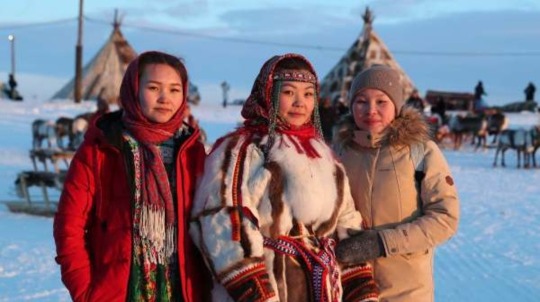
A suicide epidemic is ravaging indigenous nations in Siberia. The Uralic Nganasan community in Siberia’s northern reaches is disappearing at a shocking rate – just three decades ago, there were some 1,300. Now, there are only around 700.
In the Nganasan settlement of Ust-Avam in Krasnoyarsk Krai, there are more suicides than natural deaths. “Six people die here every year. One of these deaths is the result of natural causes. Two or three freeze or die drunk. And two or three kill themselves,” writeNovaya Gazeta special correspondents Elena Kostyuchenko and Yuri Kozyrev after visiting the region.
The community is suffering the devastating effects of global warming, man-made environmental degradation, and severe poverty fuel depression. Out of 359 residents, just 54 have jobs.
“People crack, young people in general break down. The suicide rate is higher among young people. There is no work, nothing. Here you need to pay for lighting, and need to work for food. There is no food, no work, no money,” one young resident says. Her sister also committed suicide, leaving behind an 11-year-old son.
It’s often necessary to rely on anecdotal evidence about indigenous issues. Media reports are sparse and obtaining concrete statistical evidence about indigenous tribes such as the Nganasan is tough. And some deaths may be portrayed as suicides when there is little public information about the facts (for example, the death of one 15-year-old girl, in an uncomfortably termed “relationship” with a 24-year-old adult male police officer wasstyled in 2004 as a Romeo and Juliet story by local press).
The Nganasan are the descendants of semi-nomadic reindeer hunters, with ancient roots and a shamanistic spiritual culture. Even under Peter the Great (in the 17th and 18th centuries) there was a drive to “civilize” Russians in the further-flung regions and catch up with Europe, writes historian Yuri Slezkine. Peter instructed missionaries to find native Siberians and their “seductive false gods-idols and burn them with fire … and destroy their heathen temples”. Such ideas gained greater momentum in the 20th century, and the indigenous people were later forced into reservations under the Soviets in the 1930s. Nomadic civilizations were considered fundamentally incompatible with government-sanctioned lifestyles and these “small nations” of the North were seen as somehow representative of an undesirable past.
The Soviet state collectivized their personal property, including tents, guns and traps, and even reindeer herds. This led to a complete loss of reindeer husbandry and resulted in a steep decline in the reindeer population from the 1950s onwards.
Meanwhile, Soviet enforcement of Russian literacy made the local language almost extinct. Much like practices imposed on indigenous communities in other parts of the world, the Kremlin would take away local kids from their parents and send them to study in boarding schools.
“There, speaking Nganasan was forbidden, and teachers punished them for every Nganasan word they used — beaten with canes, kicked out of the class,” said local linguist Valentin Gusev. Today, Russia is home to 260,000 people from indigenous communities – who constitute just 0.2% of the country’s population. The government officially recognizes 40 separate indigenous groups in the North, Siberia, and the Far East.
The catastrophic impact of climate change in the Russian Arctic limits the Nganasan’s fishing opportunities — their primary food source. Meanwhile, the government continues to restrict hunting, which is a widespread source of tension between the Kremlin and indigenous communities elsewhere across Russia. With a de factoban on hunting, the Nganasans stopped following the routes of wild herds. Local food available for purchase can be out of date or moldy, and chronic alcohol use continues to plague the population.
Aggressive industrial development in the Russian Arctic has massively exacerbated the crisis among the Nganasan. Last year, a Norilsk Nickel (Nornickel) diesel spillbecame the largest human-made fuel spill in Arctic history, after which Russia’s government colludedwith the company (which is the nation’s largest nickel producer) to whitewash the disaster. The spill affected the environment that provided the Nganasan with basic food supplies. “They catch fish; they hunt deer. But there are no fish this year. And the deer left for other lands three years ago,” Kostyuchenko and Kozyrev wrote.
Last year, northern indigenous tribes signed an open letterto US business magnate Elon Musk and Tesla asking him not to purchase any nickel, copper, and other materials from Nornickel in the wake of the disaster. On average, the Norilsk Mining and Metallurgical Combine plant has released 30 tons of metallic dust and heavy metal oxides annually since it began production in the late 1930s, according toresearcher Konstantin B. Klokov.
There has been a recent spikemore generally in tensions between federal authorities and indigenous communities. Some of these nations have mobilized against an over-centralized state, government-backed environmental assaults on their sacred lands, and have demanded the return of their autonomy. In Kalmykia, for example, the majority-Buddhist region has engaged in protests against a Kremlin-appointed mayor. In Buryatia, locals rallied against a rigged election for weeks. And in a case that sent waves across Russia, a Sámi activist filed a complaint with Russia’s Supreme Court last year, after the government denied him the right to hunt without a license.
#indigenous#culture#indigenous russia#indigenous russian#russia#important#fypシ#colonization#fypage#landback#siberian indigenous#siberia#indigenous siberian#siberian#russian imperialism#russian genocide#russian colonization#land back#Nganasan#Uralic
99 notes
·
View notes
Text
Crossposting from Twxttxr: some interesting news about ongoing research by colleagues, from a workshop "Diversification of Uralic" just this Thursday and Friday
Do the Permic languages have loanwords from Old Norse? e.g. ONo. ár ~ Komi & Udmurt ar 'year'. This would've been sensible during the brief time when Norsemen originally from Sweden were in charge of trade along the Volga and settling in inner Russia, forming the Rus' (later Slavicized, but as we know from Byzantine sources they remained Norse for centuries) — and also the Norwegians too were known to conduct exploration + trade along the Barents Sea at the time, our oldest written reports of "Bjarmia" come from them after all.
Do the Finnic languages have loanwords already from Pre-Proto-Germanic into Pre-Proto-Finnic? My first reply would've been "yes surely", this has been discussed for half a century and there's dozens of etymologies out by now. Turns out though that there's still a lot of room for skepticism if we try to assemble a big picture. Most of these could be (and have been proposed by other analyses) to be proper Germanic after all, or from some non-Germanic kind of Indo-European, or even incorrect. There is unambiguous evidence I think at least of loans lacking *ā > *ō, but that's already though to be one of the latest common Germanic innovations, perhaps barely post-PG.
[Follow-up question: do we even know where Pre-Proto-Germanic was spoken? might not have been anywhere convenient for contacts with Pre-Proto-Finnic.]
— A few similar problems also in the less discussed supposed layer of Proto-Balto-Slavic or pre-BSl. loans, but by areal considerations it seems obvious to me there must've been Uralic/IE contact somewhere in the Russian forest belt for ages already, even if it might not have left enough evidence to clearly distinguish from things like pre-Indo-Iranian loans.
Do the Samic languages have loanwords that are not from any historically attested branch of Scandinavian, but some sort of a lost variety entirely? This could be an explanation for an unexpected sound correspondence *j → *ć in many loans; it might also explain some loans that look surprizingly archaic, e.g. lacking any reflection of Siever's Law. One example showing both is indeed *Tāńćə 'Norse', from some sort of a *Danji- variant of Proto-Germanic *Daniz.
Several new hypotheses on the history of of sibilants in Ugric, adding to the growing tally of evidence that traditionally reconstructed *s > *θ and *ś > *s "in Proto-Ugric" are actually later developments. A paper supposed to be coming out soon!
No linguistic evidence so far, but a 1670 travelogue by de La Martinière appears to still report seemingly pre-Uralic populations along the Barents Sea coast — and even on Novaya Zemlya, traditionally thought to have been uninhabited (as reported by other early modern explorers) before some Tundra Nenets briefly settled there in mid 19th century. Apparently there's been no real archeological investigation, but also at least two stone labyrinths are known as signs that humans still must've at least visited there sometime in the past.
[By current knowledge, labyrinths from Sweden and Finland have mostly been built in late medieval and early modern times though, so they don't suggest especial antiquity either. Could the ones on NZ in fact have been left behind by some of these historical Northwest European expeditions?]
Various discussion also on the development of Samoyedic. Nothing particularly all-new (maybe on Nganasan, more on that in a PhD thesis to appear later this year though), but a few main results include 1. clear recognition that there is no "North Samoyedic" group (as has been suspected for several years now), 2. confirmation that there is regardless a narrower Nenets–Enets group, and 3. some development of a model where all three of Nenets, Enets and Nganasan may have moved to the tundra zone independently from further down south (as is certainly the case for Northern Selkup, the most recent northern expansion of Samoyedic speakers).
#historical linguistics#loanwords#language contact#archeology#ethnohistory#uralic#finnic#samic#permic#samoyedic#germanic
28 notes
·
View notes
Text
I will never not love how literal animal names are in my people's language.
Toad / Jirbaqa - jir (dirt) + baqá (frog). Dirtfrog
Turtle / Taşbaqa - taş (rock) + baqá (frog). Rockfrog
Ptarmigan / Qөrtlek - qөrt (snow pile). Snow pile thingie.
Pigeon / Qügәrçen - qügәr (to mold, to rust, to go dirty). Dirty boy 😭
Parrot / Tutı Qoş - totu (hold, catch) + qoş (bird). Held birb!
I love this language. It's so perfectly logical. It's also so cool. I'm getting better with it every day, my personal blog is now 100% in my language and I write in it a lot more confidently. 😼 Ancestors would be proud
#tatar#tatars#turkic#language#linguistic#linguistics#langblr#technically already speak 3 languages aside from this one and understand 5#poggers#grozenrant#central asian#north asian#ural#uralic#volga tatar
68 notes
·
View notes
Text
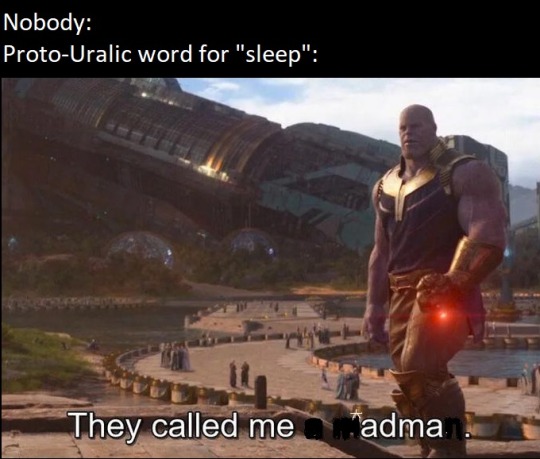
Couldn't help but make it.
10 notes
·
View notes
Text
Happy Finno-Ugric Day to all of my Hungarian, Finnish, Estonian fellows out there!
Our languages are uniqe, awesome and beautiful🤍💙🖤❤🤍💚
#finno ugor languages#finno ugric#finno ugric day#finnugor nyelv#uralic#finland#finnish#estonia#estonian#hungary#hungarian#finn#finnország#észtország#észt#magyar#magyarország#eesti#viro#virolainen#eestiläinen#suomalainen#suomi#unkari#soome#soomemaa#soomlane#ungari
48 notes
·
View notes
Text
Folksy Friday | Sanna Kurki-Suonio - Haudankaivaja (The Gravedigger) (Finnish)
#plinky celtic/medieval folk#folksy friday#sanna kurki-suonio#haudankaivaja (the gravedigger)#finnish#suomi#suo#uralic#europe#finland#2007#2000s#folk#Spotify
2 notes
·
View notes
Text
Karelian expressions of time and frequency
Konzu? When?
ammui long ago
muduači one time (in the past)
vastevai just before
terväh soon
erähiči one time (in the future)
konzutah some time
konzuliene some time (uncertain when)
konzugi that one time
hos konzu whenever
enneglästy the day before yesterday
egläi yesterday
tänäpäi today
huomei tomorrow
tossupiän the day after tomorrow
huondeksel in the morning
huondespäiväl in the forenoon
päiväl at day
keskipäiväl at midday
ildupäiväl in the afternoon
ehtäl; illal in the evening
yöl at night
huondesyöl during the small hours
mulloi; mennyt vuon last year
mennyt kuul last month
mennyt nedälil last week
tuliel nedälil next week
tuliel kuul next month
tulien vuon next year
Kui puaksuh? How often?
ainos always
puaksuh often
toiči sometimes
harvah; harvazeh rarely
nikonzu never
joga päiviä every day
joga nedälii every week
joga kuudu every month
joga vuottu every year
Äijängo kerdua? How many times?
kerran once
kahteči; kaksi kerdua twice
kolmeči; kolme kerdua thrice
nelläči; nelli kerdua four times
päiväs in a day
nedälis in a week
kuus in a month
vuvves in a year
15 notes
·
View notes
Text
Proto-uralic word of the day
The word from which the Finnish puu (tree) is probably from:
*puwe
SOME DESCENDANTS:
Tundra Nenets: пя (pya)
Kamassian: пха (pʰa)
Hungarian: fa
Komi-Permyak: пу (pu)
Komi-Zyrian: пу (pu)
Udmurt: пу (pu)
Eastern Mari: пу (pu)
Proto-Finnic: *puu
8 notes
·
View notes
Text
The Controversy of Uralic Peoples as Mongoloids


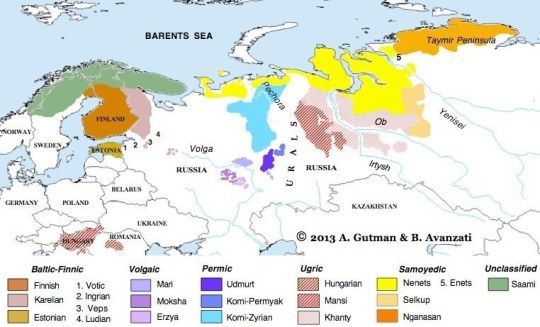

During the age of European nationalism, Finns, Hungarians, and Estonians have often had the concept of their Whiteness challenged. Some individuals have even gone out of their way to classify these three collectives as a part of the Mongoloid (East Asian) race. The strongest evidence for this claim had to do with linguistics. In the 21st century, many individuals only recognize language to be a fluid construct that has no indication of race. However, Europeans of the late 19th and early 20th century perceived language as an ethno-racial marker.
Some Western Chauvinists theorized that their shared identity of whiteness was partly ingrained in their common linguistic heritage. A broad language family identified as "Indo-European" is what loosely bound the white race together. The Finnish and Estonian tongues, however, are derived from the "Finno-Ugric" or "Uralic" language family. Because of this discrepancy, the Uralic peoples were considered Orientalized by their lack of linguistic kinship. In addition to a difference in language, certain Uralic populations also possessed physical features similar to that of East Asians. Most notably, ethnic groups like the Khanty and Mansi have pronounced epicanthic folds and maintain distinct linguistic ties with the Hungarians. These linguistic and phenotypic attributes indicated that, although the Finns, Hungarians, and Estonians appeared to be white Europeans, they were, in actuality, descendants of the Mongoloid race. These racial designations were not merely trivial ideological conflicts either. We see its impacts demonstrated when, in the United States, early Finnish immigrants were not considered white. In their book, Peter Kivisto and Johanna Leinonen note how a Finnish gentleman was denied American citizenship due to his Mongoloid origins.
This condescending view of the Finns was even shared by their fellow kin from Central Europe, the Hungarians. But why? Why would the Hungarians, a fellow Uralic-speaking people, deny any sort of linguistic/lineage tie with the Finns? This rejection is rooted in several factors tied to race, culture, and politics. In terms of politics, Hungarians have often tried to ease themselves into the sphere of pan-Turkism. This was especially prominent during the era of European nationalism when pan-Slavism was perceived as a threat to Hungary. In a reaction to Pan-Slavism, the Hungarians have often hearkened to their steppe ancestry as proof to be included as a part of a Turkic union. In addition to political factors, Hungarian history has instilled a strong sense of pride in their descent from hardened steppe warriors. The Hungarian nationalists envision themselves as the perfect syncretism of equestrian valor and . However, this romantic imagery is removed by asserting that Hungarians are related to the Uralic people. Uralic people, who were not steppe warriors, but lowly fishermen from the baron reaches of northern Europe.
The Nordicists sought to reinforce Hungary's shared origin with the Finns by emphasizing their cranial similarities. In his work Intra-Nordic Differences, Suvi Keskinen writes:
"Anders Retzius, Professor of Anatomy and Physiology,
developed a skull index to investigate “longskulls” and “shortskulls,”
coming to the conclusion that the Finns, the Sámi, and Hungarians
were to be placed among the Turanian type, understood as of Asian
origin"
Finland's history of being colonized by Sweden only added to the narrative that Uralic people were naturally meant to exist as subjugated people. This was in no way appealing to the Hungarians who sought independence from the Austrian Empire. This degrading portrayal of Finns as a subjugated and primitive race caused Hungarians to distance themselves from any sort of shared identity. In the book Languages and Publics, by Susan Gal and Kathryn Woolard, the authors note that a certain linguist was disgusted at the notion of having any sort of ancestral lineage to the Finns. In contemporary times, however, Hungarians have largely come to accept their place as members of the Uralic language family. Though others may stress the possibility of Turkic roots, one cannot deny the distant Siberian influence present across all Uralic peoples.
As the era of nationalism waned, the focus on race and ethnicity also diminished. The tumultuous aftermath of World War 2 prompted European nations to reconsider their relationships with neighboring countries. This shifting landscape gradually relieved the burden on Finns, Hungarians, and Estonians to constantly affirm their place within the Western sphere. The post-war period brought a nuanced perspective, allowing these nations a respite from the need to continually assert their Western identities.
Book Sources:
Kivisto, Peter, and Johanna Leinonen. “Representing Race: Ongoing Uncertainties about Finnish American Racial Identity.” Journal of American Ethnic History 31, no. 1 (2011): 11–33. https://doi.org/10.5406/jamerethnhist.31.1.0011.
Map Sources:
Morton, Samuel George. 1839. Crania americana or, A comparative view of the skulls of various aboriginal nations of North and South America. To which is prefixed an essay on the varieties of the human species. Illustrated byseventy-eight plates and a colored map., Philadelphia : J. Dobson; London : Simpkin.Marshall & co.
Map of human races (Meyers Konversations-Lexikon, 1885–1890)
#finland#finnish#magyar#hungarian#history#anthropology#nordic#uralic#linguistics#america#united states#sámi#europe#western civilization#maps#turkic#nomad#mongolia#asian#mongoloid#national identity#country#estonia#khanty#finno ugric#carpathians#ethnicity#hungary#european#suomi
2 notes
·
View notes
Text
Nenet tribe
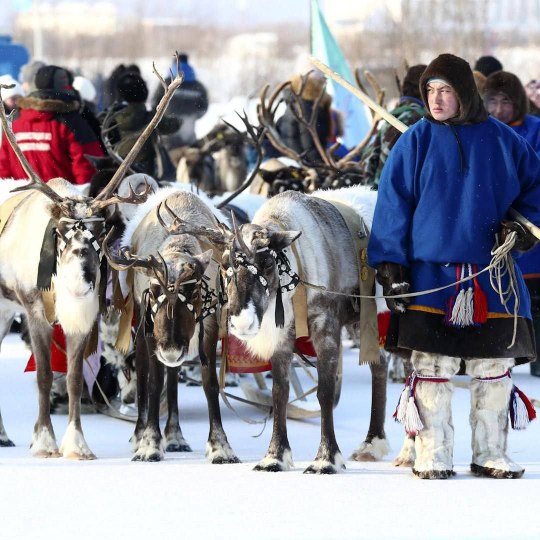

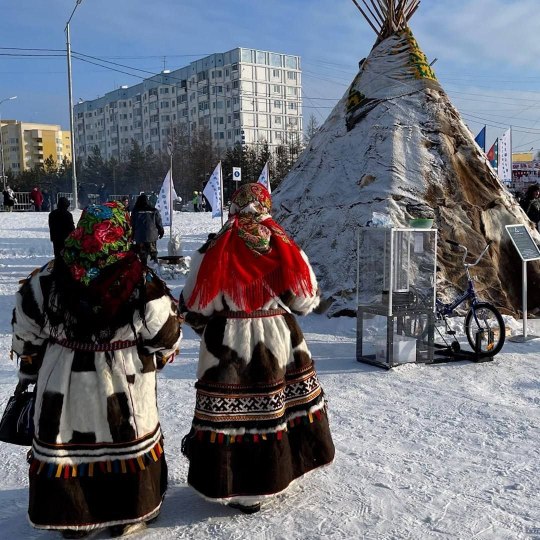


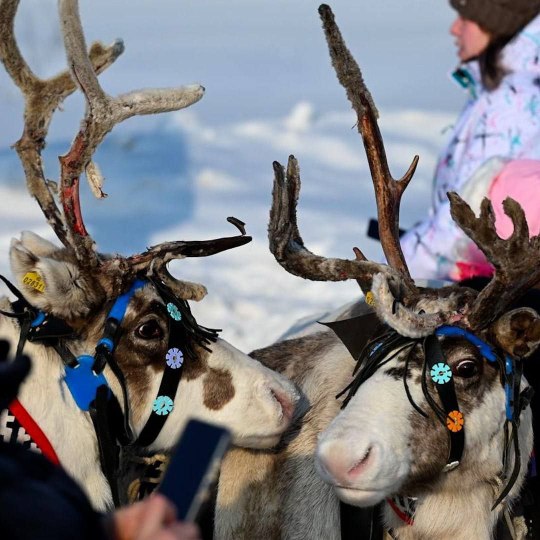
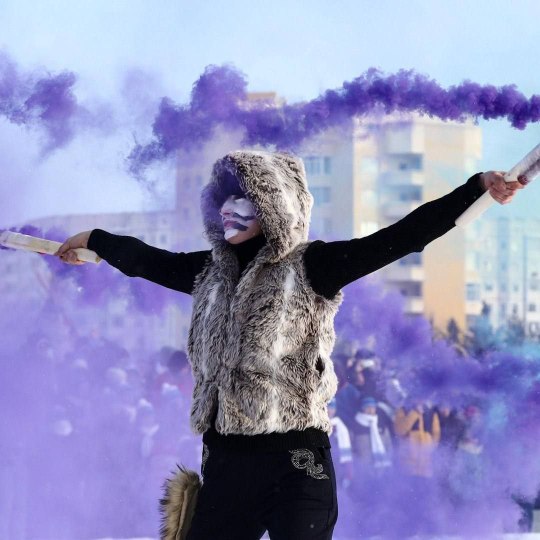
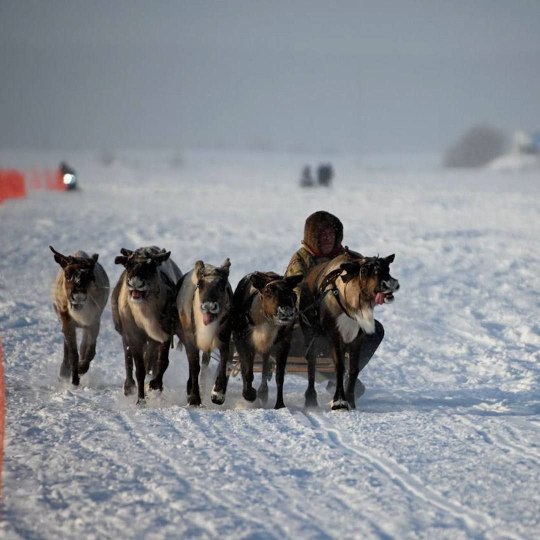
#indigenous#culture#indigenous russia#indigenous russian#important#russia#fypシ#colonization#fypage#landback#uralic#nenet people#nenets#nenets culture#Nenet#indigenous people#indigenous culture#siberian indigenous#siberia#indigenous siberian#siberian
62 notes
·
View notes
Text
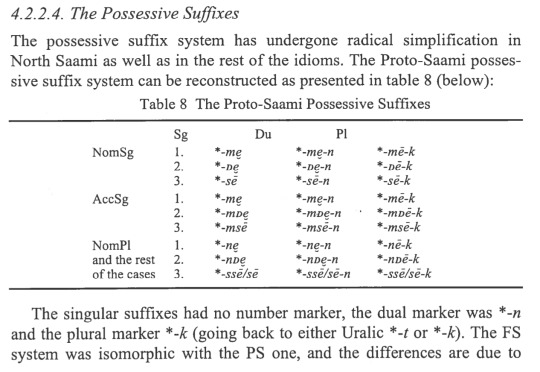
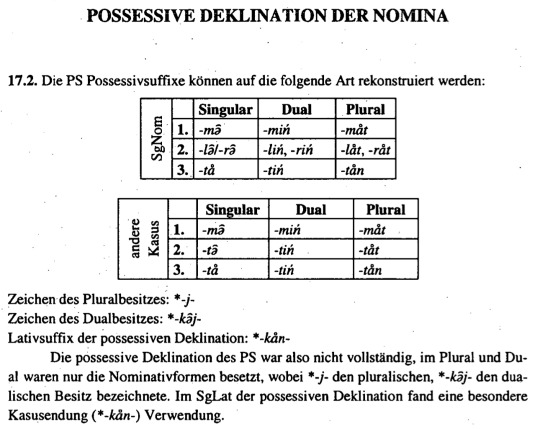
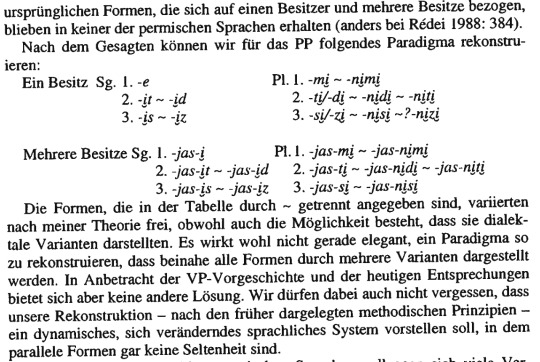
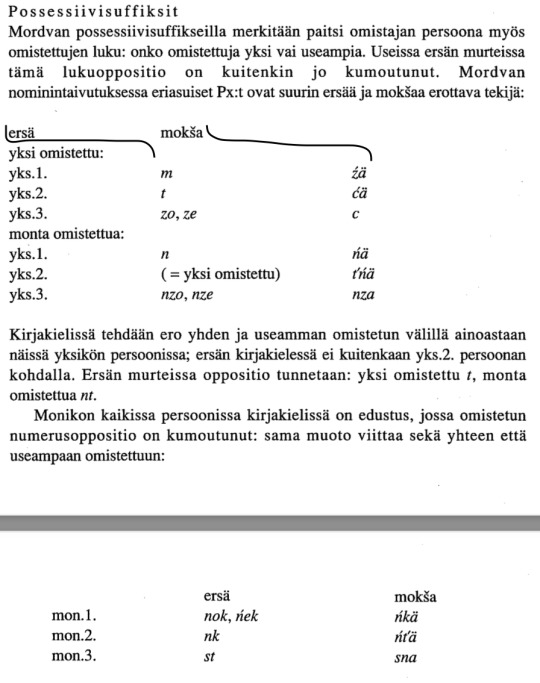
I just remembered that, despite my username, I have not posted anything about possessive suffixes on here so far; to set right this oversight, here is a small sample of possessive suffix systems across the Uralic languages from reference literature I have around
Proto-Samic, from Sammallahti 1998, The Saami Languages: An Introduction
Proto-Samoyedic, from Mikola 2004, Studien zur Geschichte der samojedischen Sprachen
Late Proto-Permic, from Csúcs 2005, Die Rekonstruktion der permischen Grundsprache
Erzya and Moksha (in the nominative), from Bartens 1999, Mordvalaiskielten rakenne ja kehitys
#comparative grammar#comparative linguistics#historical morphology#uralic#finno ugric#samic#samoyedic#permic#mordvinic
40 notes
·
View notes